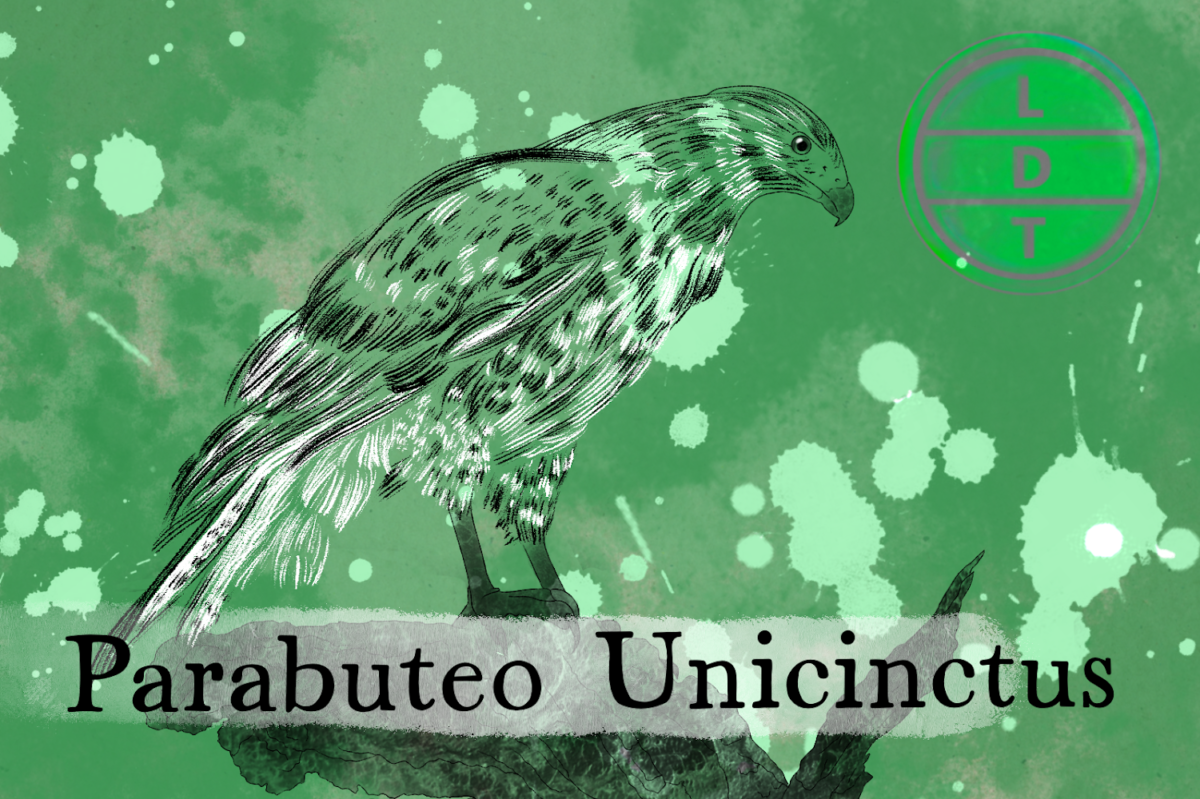“…and today we’re talking about the wolfpack of the sky. But more on that later.”
Now this is the Law of the desert— as blue and as vast as the sky;
And the Wolf that shall keep it may prosper, like the birds that hunt as they fly?
The family that hunts together, eats together. Such is the way of Harris’ Hawk, and their way is uniquely theirs. This bird is the only raptor in the animal kingdom that truly is a clever girl, hunting in a pack. But when prey is sparse and can see you coming, you’ll need help on the hunt in Life, Death, and Taxonomy.
Description of Harris’s Hawk
- Harris’ hawk is a large, intense-looking raptor
- Adults have dark brown feathers on their backs, heads, and tips of their wings. Wikipedia calls this “brownish”, but these are the brownest hawks in the verse.
- Their “shoulders” and legs are a lighter chestnut brown and their tails are tinged with white.
- Juveniles have more white (or “buff” on their undersides)
- They have sharped, hooked, yellow beaks that are tipped with gray
Measure Up
Welcome to the beloved Measure Up segment. The official listener’s favorite part of the show! The part of the show when we present the animal’s size and dimension in relatable terms through a quiz that’s fun for the whole family. It’s also the part of the show that’s introduced by you when you send in audio of yourself saying, singing, or chittering the words Measure Up into ldtaxonomy at gmail dot com. We don’t have a new Measure Up intro.
Length
- 46 to 59 cm (18 to 23 in)
- How many Haris’s Hawks go into the barrel length of the Canon de 12 Gribeauval, a French cannon used in the Napoleonic wars.
- Hint: The cannon fired a shot that was nearly 13 pounds, though in the old French pound it was 12. The gun was invented by Jean Baptiste Vaquette de Gribeauval, a French artillery officer who created his own production system that developed lighter guns that didn’t sacrifice range. He was a strong advocate for standardization and interchangeability in gun parts.
- 3.9 hawks. The barrel was 7’7’’ (231 cm).
Weight
- Females tend to be heavier at 1,029 g (2.269 lb)
- How many Harris’s Hawks go into the TNT-equivalent yield of the first nuclear bomb ever detonated?
- Hint: The 1945 Trinity nuclear test was the first to detonate a nuclear bomb. The test took place in Socorro, New Mexico and was directed by J. Robert Oppenheimer. The device was a plutonium implosion fission bomb.
- 25,052,529 hawks. The blast was the same as 25 kilotons of TNT.
Fast Facts about Harris’s Hawk
- Range: Texas, Mexico, and parts of Central and South America including Venezuela, Colombia, Peru, Bolivia, Chile, Argentina, Paraguay, Uruguay, Brazil, etc.
- Diet: small creatures including birds, lizards, mammals, and large insects
- Behavior:
- Boils of harris’s hawks are matriarchal. The females also manage the childcare
- They are apex predators, but their nests can be raided by other hawks and coyotes
- Eggs hatch in about 5 weeks and the babies are fledged in less than two months
- Lives for about 25 years in the wild
- They are used in falconry
Major Fact: Sky Wolf
Harris’s Hawk is possibly the only raptor that hunts cooperatively. These birds have brains that make them very intelligent, which makes them popular in falconry.
Most birds of prey are solitary hunters, and they may even be aggressive with one another when they are near the same kill, like the bully bald eagle.
However, the Hawk of Harris is a social bird that is known to hunt in packs.
These sky wolves cooperate by flushing out prey animals for other individuals to swoop in and catch. Packs can consist of two to six hunters. One bird will fly low or even hop on the ground to scare animals out of protective cover. Then they are exposed to the flying hunters above.
When they catch the prey, they will share–sometimes reluctantly.
Why are they the only ones?
Some researchers believe that this is an adaptation to living and hunting in the desert.
The dessert is two things, inhospitable to an abundance of life, and wide open. That means prey isn’t very densely packed. When you find an opportunity as a predator, it’s important to capitalize.
Wide open spaces mean that prey animals have good sightlines to see predators coming. Plus, there aren’t many tall trees raptors can scope out rabbits and mice from.
Scarcity forces sharing and cooperation–and it works out. Pack-hunting hawks increase their success by 10% compared to lone hawks.
Hunting groups are often made up of a mating pair and their offspring. Yearling and young hawks stick around the nest and help their parents hunt. In some cases, unrelated neighboring groups hunt together.
Ending: So don your brownest coat, take to the skies, and work together to take down your prey like Harris’ Hawk here in LDT

